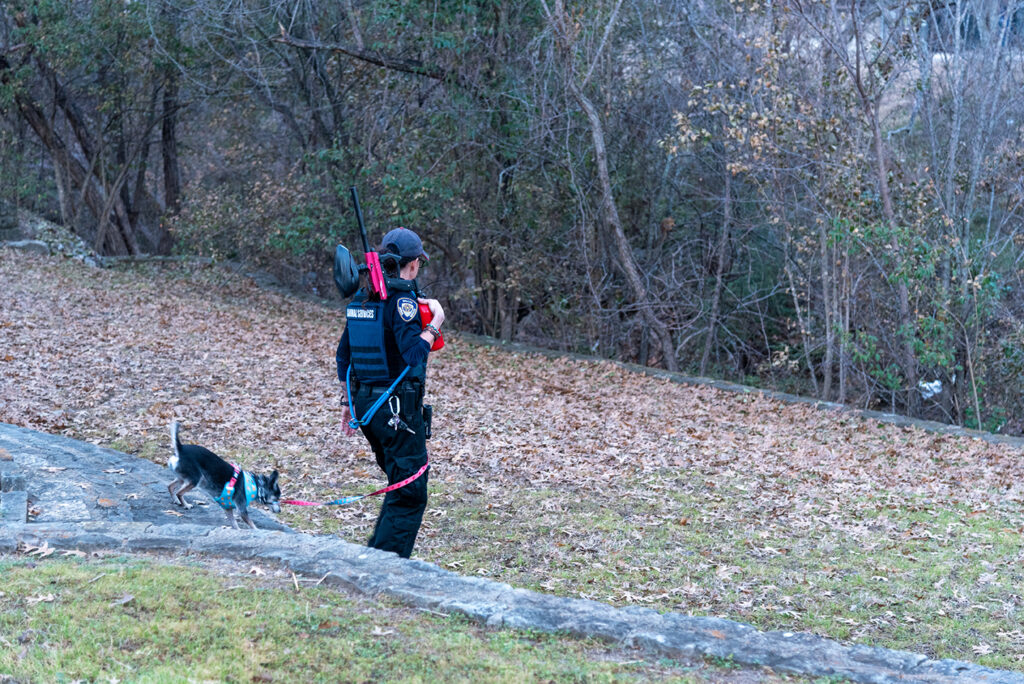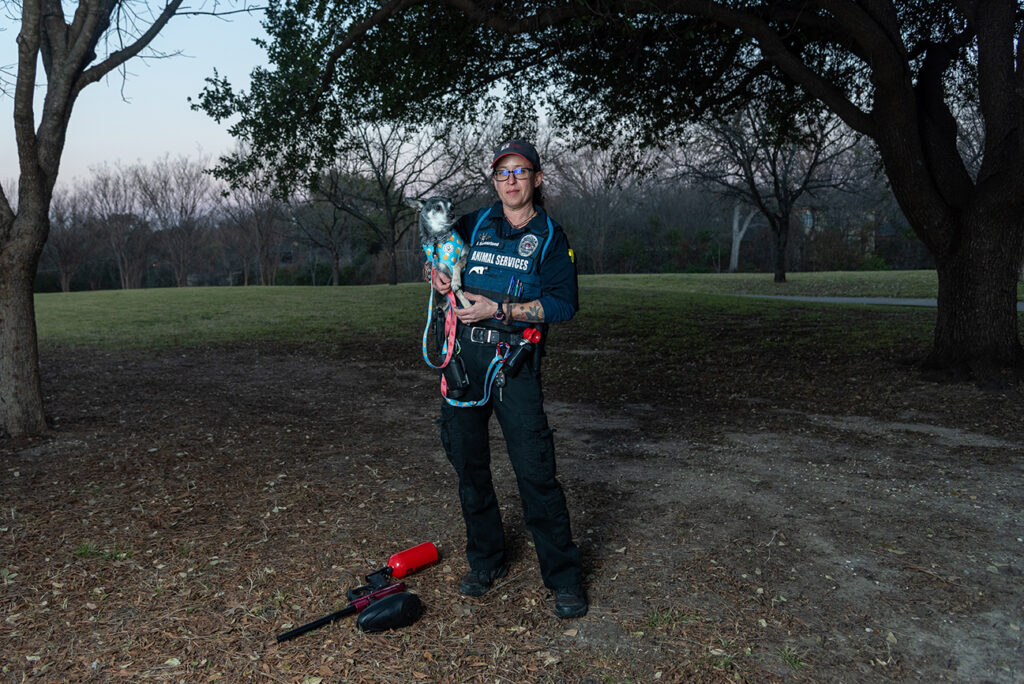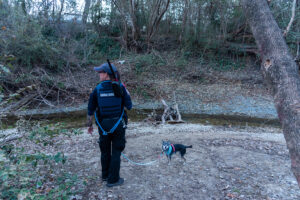
Jackie Sutherland and her dog, Missy, patrol Dallas’ wooded areas for coyotes that neighbors have reported. Missy helps Sutherland teach coyotes, through hazing, that there are negative consequences if they try to approach a dog. Photography by Julia Cartwright.
It has been almost a year since a coyote attack on a small child had Lake Highlands residents on edge.
A White Rock Valley incident involving 2-year-old Knox Thomas was the driving force behind a coyote management plan the City of Dallas launched in 2022, city spokesperson Marlo Clingman says.
Following the event, in which a coyote grabbed the boy by the throat and held on until his siblings screamed and mom charged the animal, Dallas partnered with the U.S. Department of Agriculture to create a comprehensive program to educate people and observe the animals. The goal: Broker peace between human and beast. This city web page includes a coyote reporting system and displays a map that tracks sightings.
Dallas’ coyote lady
The attack also prompted our city government to appoint a coyote czar, of sorts, whose primary role is investigating, advising and helping to coordinate wildlife policy specifically related to the increasingly problematic canines.
That’s Animal Services officer Jacqueline Sutherland. She says she was called to the scene (of the Thomas incident) immediately and led the investigation.
As the little boy underwent surgery and recovered from his injuries, Sutherland’s team, with help from USDA hunters, captured and euthanized four neighborhood coyotes.
Lethal removal is only for extreme cases. Extracting or exterminating coyotes typically does little good, Sutherland explains, because the species will breed precisely to replace each family member lost to death or relocation.
Sutherland has been Dallas’ coyote point person since that investigation.
Urban coyotes have been a hot topic in the White Rock area for decades. But until the toddler’s attack, residents had been led to believe that while cats, squirrels and small dogs are at risk, coyotes are not likely to harm humans.
It remains true that assaults on people are atypical. But when a neighborhood child is the victim, it doesn’t matter how rare they are, parents pointed out during public meetings. The city did not do enough to prevent an attack that was imminent, they said.
White Rock area dad Clayton Rainey told the Advocate last year he had reported an animal that might have been Knox’s attacker in the days before the incident. The coyote was brazenly scouring the treeline and alleys in search of food.
“It’s scary, and it should have been taken care of right then.”
Anecdotal evidence suggests an increase in Dallas’ coyote population, Sutherland says.
“In some neighborhoods, I’ve spoken with people who lived there 30 years without seeing a coyote but now (are) seeing an entire family of them,” she says.
For an even more scientific assessment, the coyote management team is analyzing data they began collecting after the White Rock Valley event.
“Now that we’re monitoring families, territories, activities, behaviors, that kind of stuff is going to give us some insight in regard to their growth and how they function and how they distribute themselves.”
Please don’t feed the fauna
What she knows for sure is that coyotes are quite content to live among people, especially when they connect a human with a food source.
“It makes them want to hang around.” And that turns into a habit for the animals and their offspring.
“People who come from Colorado or East Texas are shocked by the way the coyotes behave around here,” Sutherland says.
This habituation can result from unintentional or deliberate feeding, which does happen, Sutherland says, though people don’t want to admit to it.
She says some people use food to get good wildlife photos. That includes social media users with feeds to fill.
“I was working with an apartment where we found kids throwing food over the fence to get a coyote to come out of the woods so they could get it in a TikTok video,” she says.
The more problematic members of the coyote populations tend to be tweens, Sutherland says, because, like their human counterparts, young coyotes push the boundaries of where they are supposed to tread or how long they stay out.
These “teenage” coyotes “are going places they shouldn’t be; they’re missing curfew,” she quips. They are going to be asking a human’s permission, in a sense, to get close, and people just need to make it clear that that is not OK.
“If people are on board with that, then the behavior goes back to normal relatively quickly.”
Coyotes serve a vital role in the ecosystem by helping to control the population of rodents. That means they go where the rodents go — unsecured trash bins, for example.
Even feeding ducks and other birds can inadvertently attract coyotes, she says. An ordinance banning wildlife feeding will go to a City Council vote sometime this year, and Sutherland says it’s necessary.
Sutherland says that if everyone did their part to tackle the coyote-feeding problem, the risk of further injuries to humans would be almost nil.
“We’re really struggling to educate people about the dangers of feeding, and we’re still trying to get that (ordinance) passed,” Sutherland says. “I’ve got areas where I’m basically having to beg people to stop leaving food out in an inappropriate fashion.”
There have been a dozen or so incidents on record of coyotes attacking humans in the entire state of Texas, Sutherland says, and every one of those cases, “they’ve been able to trace back to somebody feeding the animal.”







